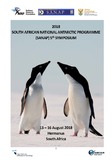
Antarctic Legacy Archive
Metagenomic derived insights of microbial communities in the Southern Indian Ocean
- ALSA Home
- →
- Documents
- →
- Research Events
- →
- View Item
JavaScript is disabled for your browser. Some features of this site may not work without it.
| dc.contributor.author | Vikram, S. | |
| dc.contributor.author | Phoma, S. | |
| dc.contributor.author | Cowan, D.A. | |
| dc.contributor.author | Makhalanyane, T.P. | |
| dc.coverage.spatial | Southern Ocean | |
| dc.coverage.spatial | Southern Indian Ocean | |
| dc.coverage.spatial | Agulhas Current System | |
| dc.coverage.spatial | Subtropical Convergence | |
| dc.date.accessioned | 2021-03-05T15:52:37Z | |
| dc.date.available | 2021-03-05T15:52:37Z | |
| dc.date.created | 18-Aug | |
| dc.date.issued | 18-Aug | |
| dc.identifier.uri | http://hdl.handle.net/123456789/28341 | |
| dc.description.abstract | To understand the oceanographic features, how they shape marine microbial ecosystems and their implications on biogeochemical cycling remains a major ecological endeavor. Recently, several studies have assessed the contribution of photoautotrophs in surface waters and related factors which shape them. However, in contrast very little is known regarding chemolithoautotrophs in the marine ecosystems generally and waters south of 40 degrees. Here, we assess microbial diversity, and functional capacity along the Agulhas current system and the Subtropical convergence in the South Indian Ocean. Samples collected from three water columns, epipelagic zone, oxygen minimum zone (OMZ. and bathypelagic zone, were analysed using shotgun metagenomics. We found high taxonomic richness in surface and deep water sample, with generally low numbers for middle samples, corresponding to the oxygen minimum zones, in contrast to other marine environments. Community analysis revealed significant dissimilarity between the three water depths; dominated by marine Proteobacteria, followed by Bacteroidetes, Actinobacteria, and Firmicutes with strikingly low relative abundance of Cyanobacteria. Our data showed evidence of extensive carbon, nitrogen and sulfur biogeochemical cycling genetic capacity with a large proportion of functional genes belonging to Alphaproteobacteria (Rhizobiales., Gammaproteobacteria (genus Pseudoalteromonas. and Cyanobacteria (genus Synechococcus.. We have reconstructed the bacterial genome bins using bioinformatics tools. The most completed genome bin shows highest similarity to the genusPsychrobacter, having genes for the sulfur and iron metabolism, suitable for the South Indian Ocean marine environment. Taken together, our results suggest differential microbial community structure along with the water columns. Functional analysis revealed a variety of traits driven by these taxa together with Proteobacteria, suggesting high functional redundancy. - Abstract as displayed in the - Abstract booklet. The presentation on the day may differ from the - Abstract. | en_ZA |
| dc.description.sponsorship | Sponsored by the the Department of Science and Innovation(DSI) through National Research Foundation (NRF) - South Africa | en_ZA |
| dc.description.statementofresponsibility | Antarctic Legacy of South Africa | en_ZA |
| dc.format | en_ZA | |
| dc.language | English | en_ZA |
| dc.language.iso | en_ZA | en_ZA |
| dc.publisher | South African National Antarctic Programme (SANAP. | en_ZA |
| dc.relation | SANAP Symposium 2018 | en_ZA |
| dc.rights | Copyright | en_ZA |
| dc.rights | Copyright | en_ZA |
| dc.subject | Research | en_ZA |
| dc.subject | Science | en_ZA |
| dc.subject | Meetings | en_ZA |
| dc.subject | Symposium | en_ZA |
| dc.subject | SANAP Symposium 2018 | en_ZA |
| dc.subject | Living Systems | en_ZA |
| dc.subject | Marine Science | en_ZA |
| dc.subject | Fauna | en_ZA |
| dc.subject | Microorganisms | en_ZA |
| dc.subject | Southern Ocean | en_ZA |
| dc.subject | Southern Indian Ocean | en_ZA |
| dc.subject | Marine Microbial Ecosystems | en_ZA |
| dc.subject | Biogeochemical Cycling | en_ZA |
| dc.subject | Agulhas Current System | en_ZA |
| dc.subject | Subtropical Convergence | en_ZA |
| dc.subject | Taxonomy | en_ZA |
| dc.subject | Genetics | en_ZA |
| dc.subject | Microbiology | en_ZA |
| dc.title | Metagenomic derived insights of microbial communities in the Southern Indian Ocean | en_ZA |
| dc.type | Abstracts | en_ZA |
| dc.rights.holder | Antarctic Legacy of South Africa | en_ZA |
| dc.rights.holder | Vikram, S. | en_ZA |
| dc.rights.holder | Phoma, S. | en_ZA |
| dc.rights.holder | Cowan, D.A. | en_ZA |
| dc.rights.holder | Makhalanyane, T.P. | en_ZA |
| iso19115.mdconstraints.uselimitation | This item and the content of this website are subject to copyright protection. Reproduction of the content, or any part of it, other than for research, academic or non-commercial use is prohibited without prior consent from the copyright holder. | en_ZA |
| iso19115.mddistributor.distributorcontact | South African National Antarctic Programme -SANAP. | en_ZA |
| iso19115.mdformat.name | en_ZA | |
| iso19115.mdidentification.deliverypoint | Antarctic Legacy of South Africa, Faculty of Science, Private Bag X1, Matieland. Stellenbosch. South Africa. | en_ZA |
| iso19115.mdidentification.electronicmailaddress | antarcticlegacy@sun.ac.za | en_ZA |
| iso19115.mdidentification.organizationname | University of Pretoria | en_ZA |
Files in this item
This item appears in the following Collection(s)
-
Research Events [494]
Material directly related to official scientific and research events
